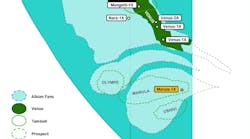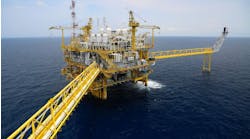Judy Maksoud
International Editor
Offshore
The American Bureau of Shipping announced the release of guidelines for using composite materials on offshore structures at the Offshore Technology Conference on May 2. ABS expects the guidelines to facilitate industry consideration of alternatives to costly steel in developing mooring systems and risers, according to Ernesto Valenzuela, offshore technology development manager.
"It is no longer a question of 'if,' but 'when' composite materials will take their first starring role in production from a deepwater hydrocarbon reservoir," Valenzuela says. "We have brought a comprehensive set of criteria to operators wanting to apply fiber reinforced plastics (FRPs) to their projects."
Valenzuela explains that the ABS Guide for Certification of FRP Hydrocarbon Production Piping Systems provides technical guidance and design procedures for using composites or FRPs on the topsides of offshore facilities.
As projects become more complex and move into deeper water, the topsides become heavier, the steel mooring systems and risers become longer and heavier, which presents serious challenges to project economics, Valenzuela says.
"These challenges have spurred research into substitute materials that would do the job of steel, but at much lighter weights. Once thought of as an exotic material, composites and FRPs are gaining acceptance among operators," says Valenzuela.
ABS plans to unveil its composite guidance in three stages: Release of criteria for FRP in topside applications, release of criteria for carbon-fiber composite riser piping and joint application, and release of criteria for composites in cryogenic piping applications.
The move to synthetic mooring lines in the past decade has been key in making some recent deepwater projects possible. It marks the offshore industry's first step away from steel and into alternate materials.
The next step is use of composites, specifically carbon-fiber materials replacing steel in production and drilling risers, and in the tendons of TLPs.
ABS' "Guide for Certification of FRP Hydrocarbon Production Piping Systems" is the first publication of its kind from a classification society and is expected to become the primary source of composite guidance available to the offshore industry. Along with its class criteria, ABS references criteria available from other organizations, including as the American Society for Testing and Materials (ASTM) and the US Coast Guard.
Advantages of carbon-fiber composites over the basic production material of steel include: higher strength-to-weight ratios, superior fatigue performance and corrosion resistance, and better thermal insulation. Another advantage is a high structural damping characteristic that makes composite risers (or tendons) immune to vortex-induced vibration, a cause of severe fatigue damage to steel structures.
Although weight is only one component in the complex considerations that make up an offshore production solution, weight reduction is among the most attractive benefits of composites.
"With less buoyancy expended on mooring systems or risers, loads can be increased, more riser joints can be stored on the rig and fitted through a smaller rotary table, or a rig could carry extra casing, mud, or chemicals," Valenzuela says.
05/02/05


